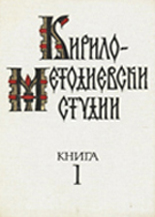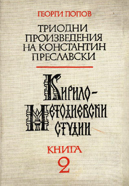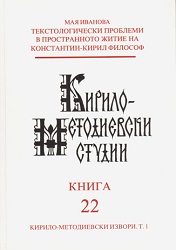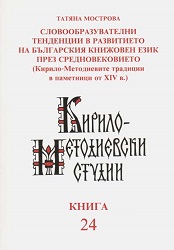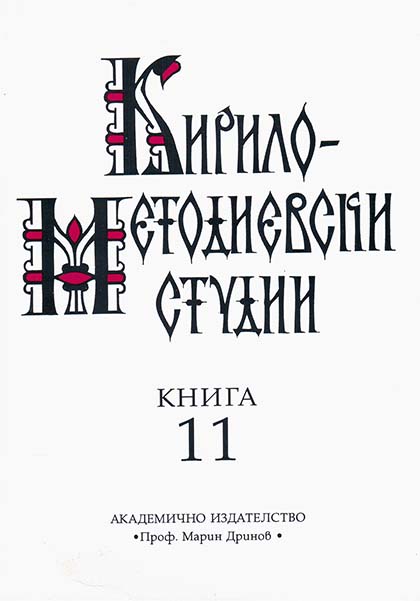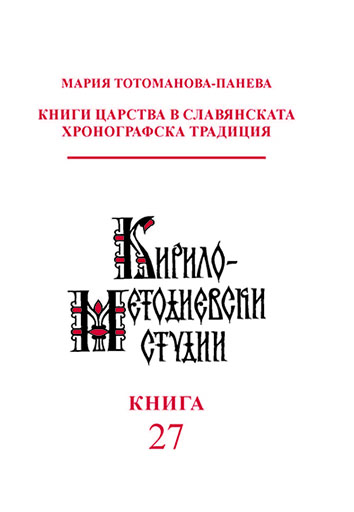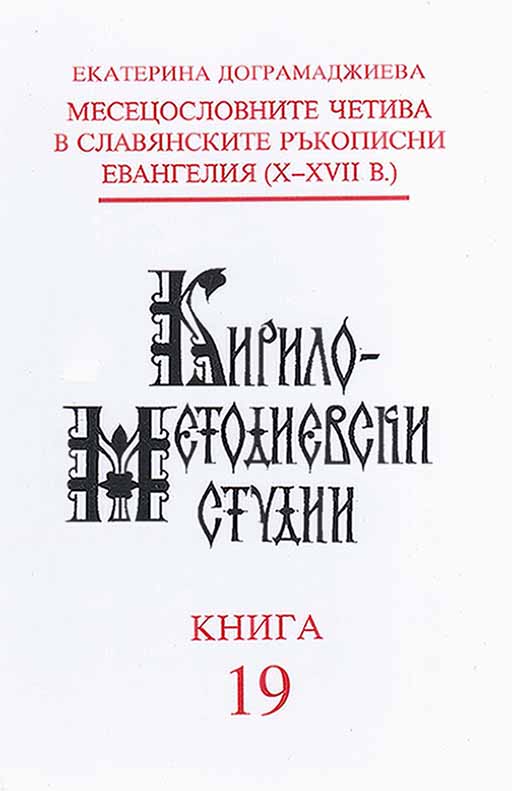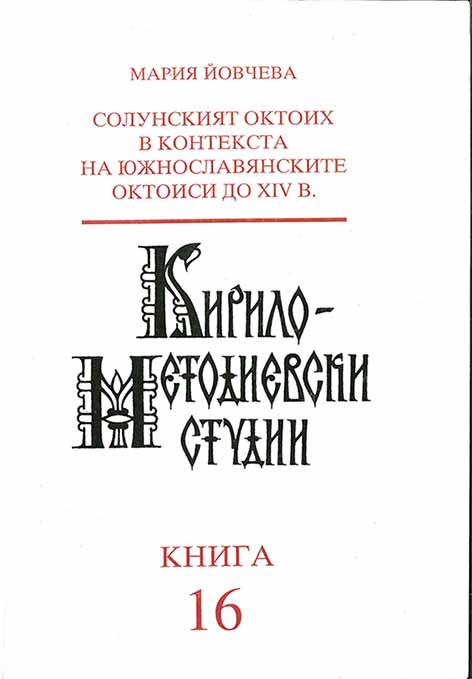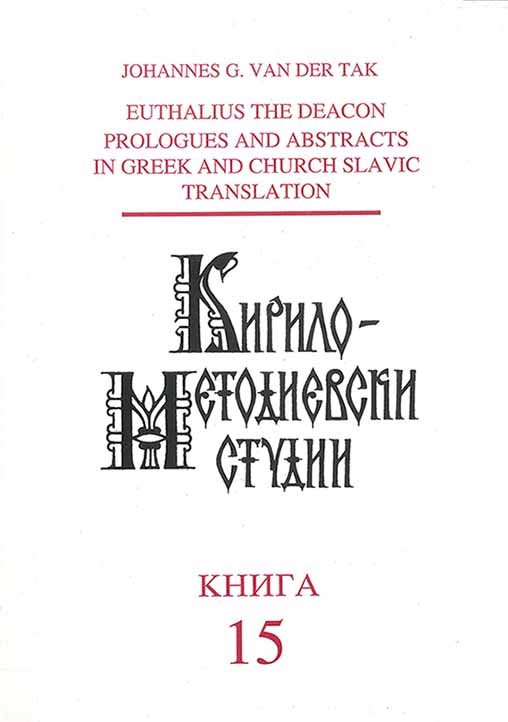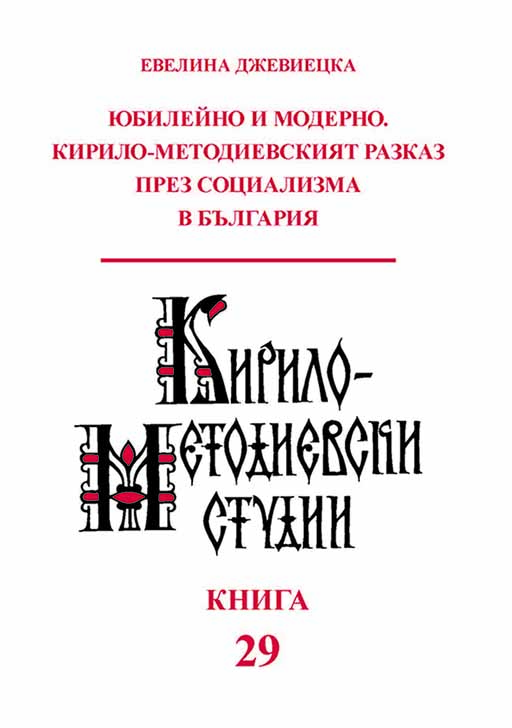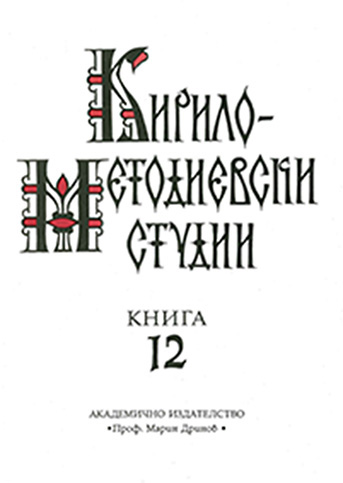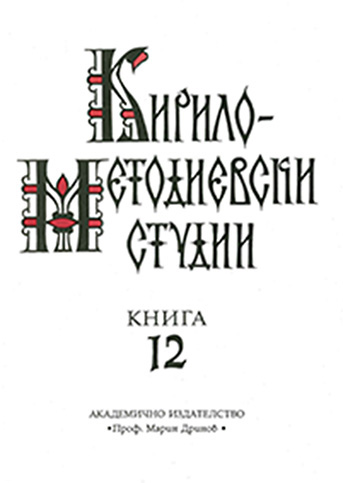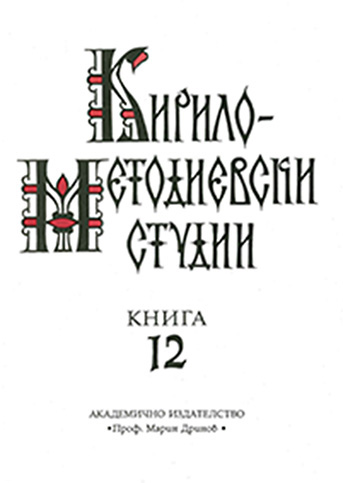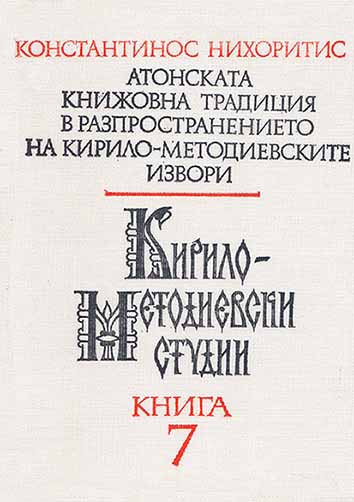Месецословните четива в славянските ръкописни евангелия (X–XVII в.) (= Кирило-Методиевски студии. Кн. 19)
Author(s): Ekaterina Dogramadzhieva / Language(s): Bulgarian,Old Bulgarian
Keywords: Slavonic gospels; Gospel menologion readings; mediaeval Slavonic manuscripts; tetraevangelia; lectionary evangelia; 10th – 17th centuries; Studite Typikon; Jerusalem Typikon
For the first time in many years of active scholarly interest in Slavonic gospels, a systematic study has been undertaken of the Gospel menologion readings and their functions, designations, and development. Material has been collected from 209 representative mediaeval Slavonic manuscripts, i.e., tetraevangelia and lectionary evangelia (full, brief and festal) in Bulgarian, Serbian and Russian copies, dating from the 10th to 17th centuries. The menologia that were written before and after the introduction of the Jerusalem Typikon differ in composition, structure and designations, so that in their description and analysis they can be divided into two groups: menologia that follow the structure of the Studite Typikon, and those influenced by the Jerusalem Typikon. The Gospel manuscript menologion is structured as a stable complex consisting of three elements: date, feast and reading (or ‘lection’). The basic unit of the menologion is the calendar day, which comes in two types: fixed and moveable. The menologion’s contents are organized according to the fixed numerical days of each month. The moveable days, which until recently have not received adequate attention, are subordinate to the moveable ones. The moveable days are neighbouring Saturdays and Sundays that direct attention to the three central Christian fixed-date feasts, i.e., the Epiphany (6th Jan.), the Elevation of the Cross (14th Sept.) and Christmas (25th Dec.), and feasts dedicated to the Fathers of the Ecumenical Councils (following 11th Oct. And 16th July). The places of these moveable days in the calendar are constant in relation to the fixed-date feasts that they commemorate, but they vary from year to year in accordance with the moveable church cycle. Thus, for example, the Saturday and Sunday before Christmas may fall immediately before 25th December, or a Monday-through-Friday sequence of days may intervene. For this reason, these Saturdays and Sundays are listed in individual manuscripts immediately following different calendar dates preceding and following 6th January, 14th September, and 25th December, and following 11th October and 16th July. The content of the menologion is the same for all types of gospels, but its location within the structure of the gospel differs, depending on whether the gospel is a tetraevangelion or a lectionary (aprakos). In all types of aprakos, the Gospel text is divided and arranged in calendar sequence, together with the necessary liturgical instructions. In the tetraevangelion also, the text is divided and supplemented with liturgical instructions, but the calendar itself comprises a table folowing the Gospel text that lists both the commemorations and lections for the calendar dates. Menologia can be divided into full menologia, which list a feast or feasts for each date of the calendar year, and short menologia, which list only selected calendar dates. Before the introduction of the Jerusalem Typikon, both types of menologia were used. Afterwards, only menologia with feasts for selected days remained, and these contained a zone of 190 free dates, unlike the menologia from the earlier period. The number and repertory of feasts for each calendar date, and the number and the repertory of lections for every feast, vary from manuscript to manuscript. There is uniformity only with respect to a limited number of dates celebrating more major feasts. As noted in chapter II, the sequence in which the feasts appear in the manuscript indicates their hierarchical rank. Menologion lections are analysed from two main perspectives, focusing on their purpose and their designations. In chapter III, I have systemized the lection pericopes according to the specific feast, or type of feast, to which they are assigned. The analysis shows that the link between feasts and lections is multifaceted and complex, but certain tendencies and preferences can be identified nevertheless. During the early period, from the 10th to mid-14th century, there were 28 narrowly specialized lections; in contrast, during the later period, from mid-14th to late 17th century, there were 58. Attention also is devoted to the issue of transfering feasts to neighbouring dates. This is a widespread phenomenon which, if not observed and taken into account, can result in misinformation. For this reason the book discusses the conditions for the emergence of this practice and how it developed. This has made it possible to trace the specific development of a group of 14 menologia of common origin, all connected to the Zograph Monastery. The book also discusses the issue of a lection’s absence as evidence that the corresponding feast has been omitted. Both feasts and lections can be omitted inadvertently by careless copyists, resulting in discrepancies. Through comparison of all the available data for the given date, these discrepancies become obvious and, in cases where a specific lection has been preserved but the name of the feast itself is omissed, the data permit the conclusion that the corresponding feast had been included in an earlier copy of the menologion. For example, on 1 September, the Church commemorates two feasts consecutively: the beginning of the new ecclesiastical year, together with a fixed lection (Lk 4:16–22); and Simeon Stylites, together with Mt 11:27–30 (in 19 manuscripts) and Mt 4:25–5:12 (in 18 manuscripts). In РГАДА816, Соф842 and Тип12, the beginning of the New Year has been omitted, but the corresponding lection (Lk 4:16–22) remains, serving as evidence that the feast had been listed for that date in an earlier copy. In the Savvina Kniga, Simeon Stylites has been omitted, but the corresponding lection (Mt 4:25–5:12) remains. A similar phenomenon is particularly frequent for church consecrations together with the specialized lections John 10:22–28/30 and Mt 16:13–18. The text used in celebrating the feast that commemorates the consecration of a church is one of the least stable components of the menologion: very often the designation of the feast is omitted, but the appropriate pericope is retained. Chapter IV discusses the way in which the lections are assigned. Since in tetraevangelia and most lectionary gospels, all the menologion lections are cross-referenced, the chapter explains the content and function of the cross-referencing. The cross-reference is a formula that consists of both obligatory and non-obligatory elements. The citation to the Gospel reading is an obligatory element. The introduction, which signals that there is a cross-reference, is not obligatory. The introduction is a construction consisting of a noun and a verb: either евангелие or слѹжьба, together with the imperative form ищи or the passive participle писано (in the Dečani Gospel, there is one instance of the form скаꙁано). In some manuscripts this information is entirely or partly omitted. The introduction is then developed. The lexeme евангелие preponderates in the mеnologia structured according to the Studite Typikon, while in those influenced by the Jerusalem Typikon the lexeme слѹжьба is used in all cases. In the early manuscripts, from the tenth to the mid-fourteenth century, the verb forms ищи and писано occur equally frequently, and often are in immediate proximity to one another in a single manuscript’s text. In later letraevangelia (from the mid-fourteenth to late seventeenth century), the verb is omitted, or, in rare cases, only ищи. The instruction guides the reader generally in four ways: 1) by indicating the location of the reading in the Gospel text, 2) by referring to another date in the calendar, 3) by pointing to a particular type of reading by means of the index called “Different Gospel readings for every need”, and 4) by providing general directions. The instructions in the Studite Typikon tetraevangelia use all four methods above; the instructions in the lectionaries use only the last three. The first way of indicating a reading consists of two components, occurring either together or separately: A) an Ammonian section, which indicates the Evangelist and the Ammonian numeral of the segment in which the pericope begins; and B) an incipit and an explicit, which specify the initial and the final boundaries of the pericope, which do not always coincide with the beginning and the end of the respective Ammonian section. In the second type of indication, the copyist provides the date in the synaxarion or mcnologion for which the same reading has already been specified. The date may be independent, or it be accompanied by specifying markers that can vary in number, combination and arrangement: these include the Ammonian section, incipit, explicit, more detailed notes such as “from the middle”, “up to the middle”, “skip to”, “read up to here”, “read up to there”. The third indication method is simplified, pointing to a specialized reading for the type of feast by referring to the index “Different Gospel readings for every need”. The fourth indication method has been found in seventeen instances, using three different formulations. In the Jerusalem Typikon menologia, the four indication methods are preserved, but changes have been made in their application. When the first indication method is used, the set consisting of Ammonian section, incipit and explicit is replaced by the pericope chapter. The Ammonian chapters give the numbers of the sense fragments, the boundaries of which do not always coincide with the boundaries of the lection, or have not been included at all in a fragment with a liturgical purpose: the pericope chapters give only the numbers of the readings. This numbering method is exact and free of ambiguity, and does not require additional explanation; hence incipits and explicits are superfluous. In very rare cases the copyist adds after the pericope chapter a date from the synaxarion which confirms the information provided. The second, cross-referencing method is still limited to lectionary gospels, which were copied during this period extremely rarely; in the tetraevangelia this method is used at a minimum. The third indication method, i.e., the pointing to a reading specialized for the type of feast by reference lo the index “Different Gospel readings for every need”, has expanded its impact and has changed its content. The fourth method, general directions, continues to be used only on rare occasions, being found in six instances and in three different formulations. Because the cross-reference is a formula consisting of figures written in letters and abbreviations, it is easy for mistakes to occur in the reading and copying processes, and since there is no meaning-based element in it, it is very difficult to notice and remove the mistakes. This creates conditions for more numerous and varied inaccuracies and mistakes than are observed in a narrative text, and gives rise to a specific range of problems. The problem of distortions in the cross-references is of special importance, because if these are not noticed and taken into account, they may lead to incorrect data and conclusions. These errors are of several types: omission of an obligatory element, improper change of an element, discrepancy between the components, and inaccurate assignment of the reading. Approximately 100 obvious distortions were found in the material from the earlier menologia under study. About 160 inaccurate cross-references were discovered by means of comparative analysis. The simplified content of the cross-references in the later manuscripts limits both the number (only 45 instances) and variety of errorss in the cross-references. The considerable variation in the content of Gospel menologia is due to the fact that (he copyist has been influenced by other manuscripts. As a result, feasts and readings are added or removed. Sometime these are omitted through carelessness. This indicates that there was a widespread practice by copyists of consulting not only the main antigraph, but also other models, sometimes not only Slavonic, but also Byzantine ones. The book’s conclusion summarizes the development of the system of menologion readings. Changes took place both synchronically and diachronically. Regarding synchronic changes, the differences among the manuscripts are in the choice of feast, combination of feasts, reading, and way in which the text is designated for each date. These changes are to a large extent a result of the copyist’s personal preference when selecting an antigraph and using additional models for collation and corrections. In practice these differences are behind the diversity of the menologia in the manuscripts. Regarding diachronic changes, processes operate in two directions. Some elements from the content and structure of the menologion gradually become rarer and ultimately vanish. Other elements gradually expand in use and become part of the stable general-use core of the menologion. In a given area the two processes may run parallel to one another. In another area they may follow a sequence one after the other: the elements that expands restricts, and in some cases replaces, an element of the same functional class. These interrelated processes in fact carry into effect the line of development. This constant process of change takes place around a stable core, which ensures the unity of the Gospel menologion during the time of its continued functioning. With regard to the structure, no change takes place in the two types of calendar days – the fixed days and the movable days (the selective menologion). With respect to the repertory of feasts, there remains a stable series of confirmed and generally accepted feasts: feasts of the Lord, feasts of the Mother of God, and feasts of the eminent apostles, martyrs and holy fathers. The set of basic lections designated for the different feasts is also retained. The ten lections that are used most often also retain their status over the two periods. The introduction of the Jerusalem Typikon, with its fundamental requirement that established rules and norms be observed, caused an essential reorganization of the structure and repertory of feasts in the Gospel menologion. The changes are apparent in five directions: 1. A restriction takes place in the number and repertory of feasts of the dates. In Jerusalem Typikon menologia, there is a reduction in the relative share of calendar dates across all the manuscripts: from 85, or c. 22%, in the early menologia to 47, or c. 12%, in the later ones. In the later menologia there is also a drop in the number of lections, from 380 to 210. The elimination of diversity during the post-Jerusalem-Typikon period also occurs through use of lections that are specialized for one given feast. The content of the cross-references is restricted. This later period saw a sizable restriction of the use of the aprakos. As a result of this marginalization, lectionary gospels were copied chiefly from Studite Typikon antigraphs, thus retaining a number of archaic features in their menologia. 2. Superfluous components are removed as a final result of this restriction. The process affects various aspects of the menologion. During the late period, full menologia were no longer used. A number of calendar dates were eliminaled entirely. 3. A limited range of feasts from the earlier period have expanded impact, and the number of dates with a stable repertory of feasts increases. 4. An introduction occurs of entirely new components into different sections of the menologion. The fixed common zone of free dates is a new phenomenon in the Jerusalem Typikon menologion, and includes more than one third of the calendar dates (190). New feasts have been included on three dates: the Feast of the Three Hierarchs (30th Jan., in 112 mss.), the Synaxis of St. Gabriel the Archangel (13th July, in 40 mss.), and Sunday of the Fathers of the Ecumenical Councils (between Oct. 11 and 12, in 137 mss.). A new means for designating lections is also introduced, i.e.,pericope chapters, which have unquestionable advantages over the old means, being brief and exact. 5. Replacement of one component of the earlier menologia with another occurs in the later menologia. In the Studite Typikon manuscripts, the Feast of the Fathers of the Seventh Ecumenical Council is observed on 11 October. In the Jerusalem Typikon manuscripts, the feast is observed on a movable day after 11 October, with considerably increased impact (six out of 137 mss.). In ten of the early menologia, from the tenth to mid-fourteenth century, a single lection is assigned to a major feast. Matins and liturgy are included in the late menologia (from the mid-fourteenth to late seventeenth century). For the feast of the Consecration of the Church of the Resurrection on 13 September, the usual lection for feasts of this type in the early menologia, Jn 10:22–30, has been replaced in full by another leclion that is common for feasts of this type, Mt 67 (= 16:13–18). Also, in the formula for feasts commemorating the consecration of a church, the earlier term свѧщение (in Carp the term обновление is used once) has been replaced by обновление. The changes in the menologion and the directions in which they take place reveal that the Jerusalem Typikon was introduced in order to achieve a higher degree of normalization and to restrict, and if possible remove, diversity on all levels. Whereas in the Studite Typikon menologia there are only 29 dates with a stable repertory of feasts, in the Jerusalem Typikon menologia there are now 78. A narrower specialization of the lections has been sought. The two spheres of feasts, central and peripheral, become more delineated. The central sphere, which includes the most venerated feasts, has the highest degree of normalization, with a narrow specialization of feast and lection, and with uniformity of realization. The peripheral sphere allows a higher degree of variation in the choice and combination of feasts and pericopes, and in the inclusion or removal of a given date from the menologion. The results show that this process has taken place so that the menologion may become more precise and easier to use. The Jerusalem Typikon itself does not contain a concrete model for this restructuring. As has already been established, the South Slavonic translations of the Jerusalem Typikon emerged in the first half of the fourteenth century: these are the first Bulgarian translation, made by Elder Ioan of the Great Laura of St. Athanasius in Mount Athos; the two Serbian translations in Nikodim’s copy of 1313 and in Roman’s copy of 1333; and the second Bulgarian translation, which is linked with the activity of Euthymius, Patriarch of Tarnovo. Each of these translations includes a full-content menologion with lections assigned according to the model provided by the Studite Typikon. The fact that the reorganization of the Gospel menologion immediately followed the introduction of the Jerusalem Typikon and was accepted everywhere at the same time as the latter is proof that the Jerusalem Typikon was the cause of the reorganization and determined it. In all probability the revision was made on the basis of a Byzantine gospel, from which it was translated and introduced into the liturgical practice of the Orthodox Slavs in the fourteenth century. The material under study is described exhaustively in accompanying tables. In this way the book shows the basis on which the analysis has been made, and on which the conclusions have been drawn. The tables are intended to piovide quick and easy checks of various features included in the description. The data from menologia written before and after the introduction of the Jerusalem Typikon are presented in two separate sections for each table. Table 1 (1.1 and 1.2) presents the material arranged by date, feast, lection and source. In table 2 (2.1 and 2.2), the material is arranged by feast together with data about the date, the lection and the number of manuscripts in which it occurs. In table 3 (3.1 and 3.2), the material is arranged by lection, together with data about the date, the feast and the number of manuscripts in which it occurs. Table 4 shows how the pericope chapters are interrelated with the liturgical fragments from the Gospel in the Targoviste Gospel, published by Makariy in 1512.
More...


